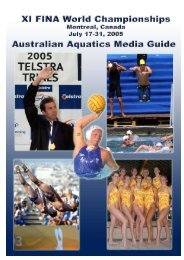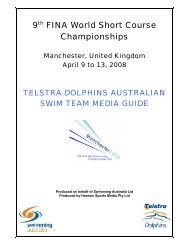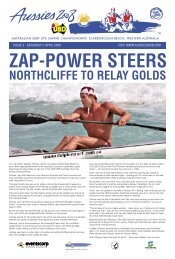Melbourne, Australia March 17- April 1, 2007 - Hanson Media Group
Melbourne, Australia March 17- April 1, 2007 - Hanson Media Group
Melbourne, Australia March 17- April 1, 2007 - Hanson Media Group
Create successful ePaper yourself
Turn your PDF publications into a flip-book with our unique Google optimized e-Paper software.
<strong>Australia</strong>n Aquatics <strong>Media</strong> Guide - XII FINA World Swimming Championships – <strong>Melbourne</strong> <strong>March</strong> <strong>17</strong> – <strong>April</strong> 1, <strong>2007</strong> © HSM<br />
AUSTRALIAN WATER POLO TEAMS<br />
MENS SQUAD WOMENS SQUAD<br />
James Stanton Emma Knox<br />
Laurie Trettel Jane Moran<br />
Grant Richardson Nikita Cuffe<br />
Anthony Martin Bronwen Knox<br />
Daniel Marsden Fiona Hammond<br />
Gavin Woods Gemma Beadsworth<br />
Peter Tresise Amy Hetzel<br />
Pietro Figlioli Mia Santoromito<br />
Richie Campbell Gemma Hadley<br />
Robert Maitland Melissa Rippon<br />
Thomas Whalan Rebecca Rippon<br />
Sam McGregor Victoria Brown<br />
Trent Franklin Suzie Fraser<br />
Johno Cottrell Kate Gynther<br />
Tim Neesham Alicia McCormack<br />
Ryan Moody Jenna Santoromito<br />
Jamie Beadsworth Sophie Smith<br />
STAFF STAFF<br />
Coach: David Neesham Coach: Greg McFadden<br />
Manager: Chris Harrison Manager: Jeanette Gunn<br />
Assistant Coach: John Fox Assistant Coach: Eddie Dennis<br />
Assistant Coach: David Swift Assistant Coach: Aleks Osadchuk<br />
Video Analyst: Mark Hubbard Assistant Coach: Ryan Moar<br />
Physiotherapist: Andrew Stanford Physiotherapist: Danealle Lilley<br />
Physiotherapist:James Sutherland Doctor: Grace Bryant<br />
Doctor: Grace Bryant<br />
A BIT OF HISTORY<br />
In the middle of the 19th century in Great Britain, water polo was played as an aquatic version of polo. Gaining<br />
in popularity, it was made part of the Olympic program in Paris in 1900, where it became the first team sport in<br />
the modern Olympics. Great Britain won the gold.<br />
Water polo has evolved with the times. In its beginning, it was an extremely aggressive sport, where fights<br />
were commonplace. Players were held underwater and clutching on to swimming suits was part of the game.<br />
In 1911, FINA adopted the official rules of water polo, inspired by the Scottish version of the game with its<br />
emphasis on passing and scoring.<br />
At the Sydney Olympic Games in 2000, a women’s event was included for the first time.<br />
HOW THE GAME IS PLAYED<br />
Water polo players are not allowed to touch either the sides or the bottom of the pool. The match is divided<br />
into 4 periods of 7 minutes each, and is recognized as one of the most demanding sports in the world.<br />
Combining technique and endurance, the swimmers must have the skill of basketball players to execute their<br />
dribbling, passing and shooting. Teams are comprised of 13 players, only seven of whom may be in the water<br />
at any one time.<br />
There are many technical fouls for which penalties are called: holding the ball underwater with two hands<br />
(except the goalkeeper); hitting the ball with the head, the fist or the foot; changing position during a stoppage<br />
in play; keeping an opponent underwater and interfering with or splashing water in the face of an adversary.









